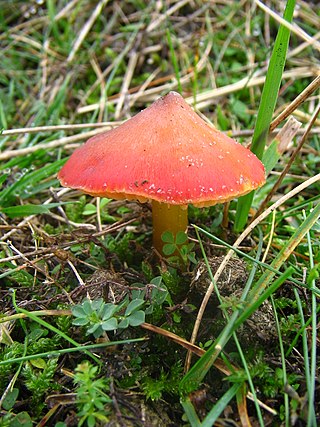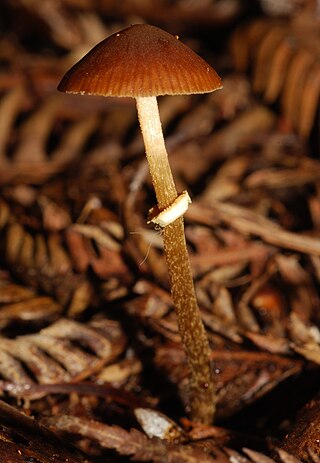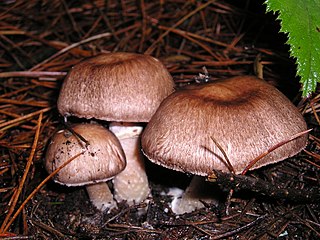
Hygrocybe conica is a species of agaric in the family Hygrophoraceae. In the UK it has been given the recommended English name of blackening waxcap, since all parts of the basidiocarp blacken with age. In North America it is commonly known as the witch's hat, conical wax cap or conical slimy cap. Hygrocybe conica is known to be a complex of at least eleven closely related species and as such is widespread in Europe, North America, Asia, and elsewhere.

Pholiotina rugosa is a common mushroom which is widely distributed and especially common in the Pacific Northwest. It grows in woodchips, flowerbeds and compost. It has been found in Europe, Asia and North America. It contains the same mycotoxins as the death cap. It is more commonly known as Conocybe filaris as this is the name it is likely to appear under in field guides. However, Conocybe filaris is a junior synonym of Pholiotina rugosa. Pholiotina rugosa has also been placed in the genus Conocybe, but its morphology and a 2013 molecular phylogenetics study place it in the genus Pholiotina. Pholiotina fimicola, which grows on dung and rich soil in North America, is a possible synonym. Pholiotina arrhenii has also been considered a possible synonym, but a molecular phylogenetics study found it to be a distinct species.

Pholiotina smithii is a rare member of the genus Pholiotina which contains the hallucinogenic alkaloid psilocybin. It was formerly known as Galera cyanopes.

Agaricus subrutilescens, also known as the wine-colored agaricus, is a mushroom of the genus Agaricus. It was first described scientifically in 1925 as Psalliota subrutilescens, and later transferred to Agaricus in 1938.

Pluteus salicinus is a European psychedelic mushroom that grows on wood. It is an edible mushroom after parboiling.

Lactarius rubrilacteus is a species of mushroom of the genus Lactarius. It is also known as the bleeding milkcap, as is at least one other member of the genus, Lactarius sanguifluus.

Conocybe apala is a basidiomycete fungus and a member of the genus Conocybe. It is a fairly common fungus, both in North America and Europe, found growing among short green grass. Until recently, the species was also commonly called Conocybe lactea or Conocybe albipes and is colloquially known as the white dunce cap or the milky conecap. Another common synonym, Bolbitius albipes G.H. Otth 1871, places the fungus in the genus Bolbitius.

Panaeolus papilionaceus, also known as Agaricus calosus, Panaeolus campanulatus, Panaeolus retirugis, and Panaeolus sphinctrinus, and commonly known as Petticoat mottlegill, is a very common and widely distributed little brown mushroom that feeds on dung.

Panaeolus semiovatus var. semiovatus, also known as Panaeolus semiovatus and Anellaria separata, and commonly known as the shiny mottlegill, ringed panaeolus, or egghead mottlegill, is a medium-sized buff-colored mushroom that grows on horse dung, and has black spores. Though nonpoisonous, it is generally regarded as inedible, and a few people experience gastric upset after consumption.

Gymnopilus sapineus, commonly known as the scaly rustgill or common and boring gymnopilus, is a small and widely distributed mushroom which grows in dense clusters on dead conifer wood. It has a rusty orange spore print and a bitter taste. This species does not stain blue and lacks the hallucinogen psilocybin.

Gyromitra caroliniana, known commonly as the Carolina false morel or big red, is an ascomycete fungus of the genus Gyromitra, within the Pezizales group of fungi. It is found in hardwood forests of the southeastern United States, where it fruits in early spring soon after snowmelt.

Pholiotina is a genus of small agaric fungi. It was circumscribed by Swiss mycologist Victor Fayod in 1889 for Conocybe-like species with partial veils. The genus has since been expanded to include species lacking partial veils.

Hydnellum aurantiacum is an inedible fungus, commonly known as the orange spine or orange Hydnellum for its reddish orange or rusty red colored fruit bodies. Like other tooth fungi, it bears a layer of spines rather than gills on the underside of the cap. Due to substantial declines in sightings, this species is listed as critically endangered in the United Kingdom.

Cyptotrama asprata, commonly known as the golden-scruffy collybia or spiny woodknight is a saprobic species of mushroom in the family Physalacriaceae. Widely distributed in tropical regions of the world, it is characterized by the bright orange to yellow cap that in young specimens is covered with tufts of fibrils resembling small spikes. This fungus has had a varied taxonomical history, having been placed in fourteen genera before finally settling in Cyptotrama. This species is differentiated from several other similar members of genus Cyptotrama by variations in cap color, and spore size and shape.

Agrocybe pediades, commonly known as the common agrocybe, is a typically lawn and other types of grassland mushroom, but can also grow on mulch containing horse manure. It was first described as Agaricus pediades by Swedish mycologist Elias Magnus Fries in 1821, and moved to its current genus Agrocybe by Victor Fayod in 1889. A synonym for this mushroom is Agrocybe semiorbicularis, though some guides list these separately. Technically it is edible, but it could be confused with poisonous species, including one of the genus Hebeloma.

Crepidotus mollis, commonly known as the peeling oysterling, soft slipper, jelly crep, or flabby crepidotus, is a species of mushroom. It's edibility is unknown, but it is probably inedible and possibly poisonous.

Clavaria zollingeri, commonly known as the violet coral or the magenta coral, is a widely distributed species of fungus. It produces striking tubular, purple to pinkish-violet fruit bodies that grow up to 10 cm (3.9 in) tall and 7 cm (2.8 in) wide. The extreme tips of the fragile, slender branches are usually rounded and brownish. A typical member of the clavarioid or club fungi, Clavaria zollingeri is saprobic, and so derives nutrients by breaking down organic matter. The fruit bodies are typically found growing on the ground in woodland litter, or in grasslands. Variations in branching and color can often be used to distinguish C. zollingeri from similarly colored coral fungi such as Alloclavaria purpurea and Clavulina amethystina, although microscopy is required to reliably identify the latter species.

Amanita atkinsoniana, also known as the Atkinson's amanita, is a species of fungus in the family Amanitaceae. The fruit body is white to brownish, with caps up to 12.5 centimetres in diameter, and stems up to 20 cm long. The surface of the cap is covered with brownish conical warts.

Peziza varia, commonly known as the Palomino cup or recurved cup, is a species of fungus in the genus Peziza, family Pezizaceae.

Conocybe aurea is a basidiomycete fungus in the family Bolbitiaceae.




















